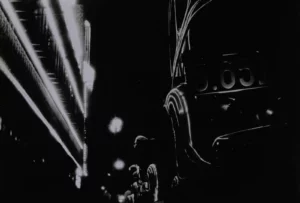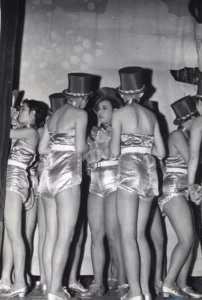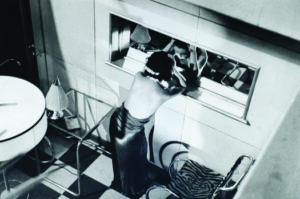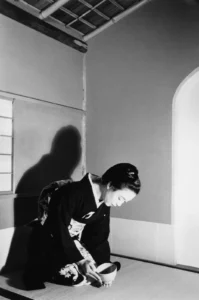Hamaya Hiroshi, the renowned photojournalist, began his career documenting Tokyo in the 1930s. In the 1940s and 50s, he traveled extensively in rural Japan, photographing the landscape, the people, and their daily lives. In the 1960s he returned to Tokyo and captured students protesting the U.S.-Japan security treaty.1 While his work is wide-ranging, much of his photography focuses on the human experience and the social spaces which serve as a backdrop for daily interactions.

In his early photography, Hamaya captured the urban life of Tokyo in the 1930s, with a focus on dancehalls and social dancers. The Ginza district, in particular, was renowned for its vibrant nightlife, including dancehalls, jazz bands, and taxi-dancers, women who could be hired as dance partners. One of Hamaya’s 1934 photographs depicts a line of taxis at night, waiting for customers in Ginza, suggesting the similarities between hiring taxis and dance partners, both of which lined up to wait for paying customers.2 Beyond depicting life in the city, Hamaya’s photographs also document the rise of consumerism. The commercial nature of the dancehalls was a stark reality the women who worked there. For men, they were social spaces of leisure, but for women they were often spaces of labor.3
The rise of consumerism was evident in the popularity of dancehalls as well as the emergence of a new type of woman: the “modern girl” who could be recognized by her western style, short dresses, and bobbed hair. She was not only defined by her appearance but also the places she visited, such as “the café, the cinema, the theater, the department store, the ocean liner, and the dancehall.”4 In Japan, the modern girl was a symbol of progress, but she was also relentlessly attacked by the media. In popular culture, she was often sexualized to represent her threat to morality and “her daring bob stood out as a graphic illustration of the rise of consumerism.”5 The modern girl demonstrated that women could be financially independent, but the self-commercialization of taxi-dancers undercut this progressive image by associating the modern girl with the negative aspects of consumerism.

Hamaya’s dancehall photography presented alternative views of the spaces and the dancers. While dancehalls were places of female labor, male socialization, and venues that presented the opportunity for men and women to be in close proximity, Hamaya’s photograph of revue girls at Nichigeki Theatre in 1938 shows the women at rest, socializing with each other.6 Photographing the women in between performances reveals another side of the social space of dancehalls outside their intended purpose. Similarly, Hamaya’s photograph of a woman looking at herself in a mirror in the Florida dancehall in 1935 reveals a moment of rest and solitude in a space designed for constant activity and crowds.7 These photographs humanize their subjects and present an alternative to the highly sexualized image of the “modern girl.”


His later photographs capture social spaces that are uniquely Japanese, like bathhouses, festivals, and tea ceremonies.8 His photographs of the rural labor of rice farmers, fishermen, and folk dancers reveal a fascination with “social customs that some would consider quintessentially Japanese,” and he “pictured the Japanese folk as a way of typifying human responses to the environment their work practices for survival necessitated.”9 The social spaces, customs, and labor of rural Japanese people in these photographs were essential aspects of rural life, if not survival. Like these rural spaces and practices, the dancehalls of the 1930s were an important aspect of Japanese life in the city and the labor of social dancers was simply one way of surviving in an urban environment. While critics of the modern girl targeted her morality and sexualization, “Their elitism mirrored their hostility toward consumerism and their inability to see the modern girl in her role as a modern construct.”10 Hamaya humanized their labor and presented an alternative view of the modern, working woman.9
- John Clark, “Hamaya Hiroshi (1915–1999) and Photographic Modernism in Japan,” Self and Nation, Vol. 7, Issue 1 (Fall 2016). [↩]
- “Taxis Waiting for Customers, Ginza, Tokyo, 1934,” Michael Hoppen Gallery, https://michaelhoppen.viewingroom.com/content/feature/47/artworks-6748-hiroshi-hamaya-taxis-waiting-for-customers-ginza-tokyo-1934-printed-1960/. [↩]
- Vera Mackie, “Sweat, Perfume, and Tobacco: The Ambivalent Labor of the Dancehall Girl,” in Modern Girls on the Go: Gender, Mobility and Labor in Japan, eds. A. Freedman, L. Miller & C. Yano (Stanford: Stanford University Press, 2013), 68. [↩]
- Mackie, “Sweat, Perfume, and Tobacco,” 71. [↩]
- Barbara Sato, “The Modern Girl as a Representation of Consumer Culture,” in The New Japanese Woman: Modernity, Media, and Women in Interwar Japan, eds. Rey Chow, Harry Harootunian, & Masao Miyoshi (New York: Duke University Press, 2003), 77. [↩]
- Hamaya Hiroshi, “Revue girls, Nichigeki Theatre, Yurakucho, Tokyo, 1938,” Michael Hoppen Gallery, https://www.michaelhoppengallery.com/artists/125-hiroshi-hamaya/overview/#/artworks/9804. [↩]
- Hamaya Hiroshi, “Dancer Looking Herself in a Mirror, Ballroom Florida, Akasaka, Tokyo, 1935,” from Alexandra Lange, “‘Deco Japan’ + Designing Women,” Design Observer, March 26, 2012. [↩]
- Hamaya Hiroshi, “A Woman Performing the Tea Ceremony,” Michael Hoppen Gallery, https://michaelhoppen.viewingroom.com/content/feature/47/artworks-2544-hiroshi-hamaya-a-woman-performing-the-tea-ceremony/. [↩]
- Clark, “Hamaya Hiroshi (1915–1999) and Photographic Modernism in Japan.” [↩] [↩]
- Sato, “The Modern Girl as a Representation of Consumer Culture,” 68. [↩]